Laurence Brahm
| Laurence Brahm | |
|---|---|
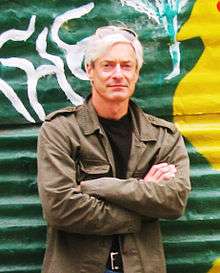 Laurence Brahm in Kathmandu, Nepal during peace process negotiations. | |
| Born |
March 31, 1961 New York City, New York |
| Occupation |
Global Activist Author Social Entrepreneur Political Economist International Mediator Lawyer |
Laurence J. Brahm (born March 31, 1961) an American international crisis mediator and lawyer, global activist, author and pioneer social entrepreneur. He is the founder of Himalayan Consensus, a NGO, and the African Consensus movement, both dedicated to protecting ethnic diversity through sustainable economics and the fight against climate disruption. Brahm is also founder and CEO of Shambhala Serai, one of Asia's first social enterprises.
As founder and executive director of Himalayan Consensus Institute he oversees the “Himalayan Consensus Process” that establishes a second track dialogue between stakeholders in the region toward combatting climate disruption and empowering communities facing climate impact. He is a member of the Himalaya – Third Pole Circle established by Iceland’s President Olafur Ragnar Grimsson and serves as policy advisor to ICIMOD’s Hindu Kush Himalayan Assessment Mapping Program.
He was NGO spokesperson to the United Nations Earth Summit 2012 (Rio+20) and selected by ScenaRio as one of the “100 Opinion Leaders Advising Rio +20”. In 2011 he led NGO side events at the UNFCCC Durban Cop 17 2010 he received the UNDP Award for Bio-Diversity and Cultural Protection in China presented by Jane Goodall.
Since 2012 he has advised China’s Ministry of Environmental Protection and drafted a comprehensive “green print” to shift from fossil fuels to renewables that was adopted national policy for re-greening China on April 25, 2015. He currently advises Bhutan’s National Environmental Commission on waste, water and environmental regulatory frameworks.
In 2015 he was invited to serve as Foreign Policy Adviser to the 2016 Presidential campaign of Jill Stein, American Green Party candidate.
Education
Laurence Brahm studied Intensive Mandarin Language in 1981 at Nankai University in Tianjin, China near Beijing. In 1982, he studied Political Science Studies at the Chinese University of Hong Kong. He went on to receive his Bachelor of Arts Degree in Political Science from Duke University in 1983. In 1987, he received both his Masters in Asian Studies with a major in Politics and a minor in Economics and Juris Doctor from the University of Hawaii School of Law and Center for Asian Pacific Studies. Laurence Brahm received his Masters in Law from the University of Hong Kong Faculty of Law in 1989.
Books by Laurence Brahm
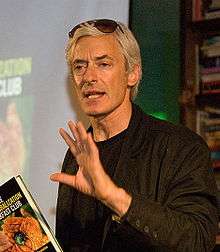
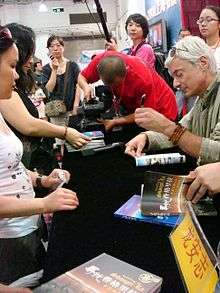
| Book Title | Publisher | Date Published |
|---|---|---|
| FUSION ECONOMICS: How Pragmatism is Changing the World | Palgrave Macmillian | 2014 |
| The Anti-Globalization Breakfast Club | John Wiley | 2009 |
| Searching for Shangri-la | Marshal Cavendish | 2006 |
| Conversations with Sacred Mountains | Marshal Cavendish | 2006 |
| Shambhala Sutra | Marshal Cavendish | 2006 |
| New Age Sutra | South China Morning Post/Continental Press | 2006 |
| When Yes Means No | Tuttle | 2002 |
| Sun Tzu for Business | Tuttle | 2002 |
| The Art of the China Deal | Tuttle | 2002 |
| China Elements | China Continental Press | 2001 |
| Zhu Rongji – The Transformation of Modern China | John Wiley & Sons | 2001 |
| China’s Century | John Wiley & Sons | 2000 |
| Foreign Investment and Trade Law in Vietnam | Asia | 2000,1991 |
| Foreign Exchange Controls and Strategies for the PRC | Longman | 1999 |
| Intellectual Property Law in the PRC | Longman | 1998 |
| Re-engineering China | Naga | 1998 |
| Zhu Ge Liang’s Art of Crisis management for China Joint Ventures | Naga | 1997 |
| Red Capital | Naga | 1997 |
| Sun Tzu’s Art of Negotiating in China | Naga | 1996 |
| Negotiating in China 36 Strategies | Reed | 1996 |
| China As No. 1 | Butterworths | 1996 |
| The Business guide to China | Butterworths | 1996 |
| The Laos Investment Guide | FT Pitman; co-author | 1995 |
| Banking and Finance in China | Butterworths | 1995 |
| Negotiating in China 36 Strategies | Reed Publishing | 1995 |
| China Inc | Butterworths | 1995 |
| Vietnam: Banking and Finance | Butterworths | 1994 |
| The China Forex Guide | Longman; co-author | 1993 |
| Intellectual Property & Technology Transfer in China | Longman | 1993 |
| Intellectual Property & Technology Transfer in Vietnam | Longman | 1993 |
| The Vietnam Customs Guide | Longman | 1993 |
| Foreign Exchange controls in China: A Strategic Guide for Corporate Survival | Longman | 1992 |
| Banking and Finance in Indochina | Simon & Schustor | 1991 |
| Investment in the Lao PDR | Longman | 1989 |
Career
Economic advisor
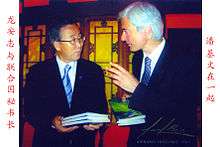
The idea that is Himalayan Consensus evolved from Brahm’s years as a central government advisor in Laos, in 1991–92, and Vietnam, . He opposed the “shock therapy” policy prescriptions of the Washington Consensus. During his advising years, Brahm began drafting the overarching financial reforms and accompanying policy legislation that led to economic take-off and continues to serve as the development framework for these countries to this day. He was one of the first people to refer to the term "compassionate capitalism". Two decades later, Vietnam and Laos are examples of the success of Brahm’s policy advice.[1]
Brahm advised for Cambodia, Mongolia, and China under the economist, former Premier Zhu Rongji. He worked with Zhu during the critical years that supervised China’s transition from Planned Economy to Market Economy. Brahm was a member of Zhu’s economic advisors that paved the way for China’s entry into the WTO in 2001. Laurence Brahm coined the phrase “China Century” theory which juxtaposed the “China Collapse” theory held by certain scholars in the West. Brahm documented the reforms that he personally witnessed in his biography of Zhu in “Zhu Rongli – the Transition of Modern China.”[2][3]
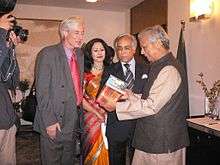
In 2013, Brahm was called back to China from Africa and asked to provide advice on a comprehensive “green print” of “environmental economics” to transition China from its heavy reliance on fossil fuels to low carbon energy and to define the nascent concept of “ecological civilization” (China’s version of sustainable development). Drawing on experience from the Zhu Rongji era he drafted a series of policy papers calling for: national fixed asset investments and credit-fiscal policies for renewable and efficient energy, re-balancing growth calling for new measurements outside of traditional GDP with a new focus on health and environment, and revision of the national education system to promote values of conservation rather than over consumption, and strict requirements for new urban construction requiring smart, low carbon, green cities with infrastructure for water conservation and recycling. These ideas were adopted by the administration of President Xi Jinping in a document issued on April 25, 2015 called “Opinions of the Central Committee of the Communist Party of China and the State Council on Accelerating the Development of Ecological Civilization.”
Following China’s entry into the WTO in 2001, Brahm shifted his focus from coastal China to the western regions, moving to the Himalayan Plateau. Since 2002, Laurence Brahm has refused any further engagement with multinational corporations as an investment advisor and strategist. In the following years, he formed Himalayan Consensus.[4]
On the 30th anniversary of Open Door Policy, Laurence Brahm was selected by China Central TV as one of the ten non-political figures contributing to China's economic opening and reform. He was the only foreigner chosen.[5]
Himalayan Consensus
Himalayan Consensus, officially founded in 2005, is a NGO for protecting ethnic diversity, culture and environment and is a member of the United Nations Theme Group on Poverty and Inequality, United Nations Global Compact, and in the process of becoming a member of ECOSOC.
The three pillars that the Consensus was found on include: Supporting ethnic diversity and indigenous identity, through sustainable economic platforms such as micro-finance and social entrepreneurship, while prioritizing environmental protection and community development[6] This theory is a reaction to popular economic and development theories. Himalayan Consensus openly stands against theories that have been promoting across many developing countries that focus should be on rebuilding from the top down. Laurence Brahm’s theory endorses development from the group up. The local population need to be given the proper tools to develop economically while preserving culture and tradition.[7] Laurence Brahm believes, “the Himalayan Consensus is based on one principle: preserving and maintaining ethnic diversity, culture, heritage and the environment through a sustainable economic platform.”[8] The Himalayan Consensus works towards empowering people with local pragmatism in place of globalization ideology and theory. Brahm’s theory has been called, “an innovative approach to development.”
In 2009, Himalayan Consensus was invited by the United Nations to become a member of the United Nations Theme Group for Poverty and Inequality. The UN recognizes the Himalayan Consensus as an effort to reduce poverty levels while protecting cultural sustainability. Himalayan Consensus works with other groups who support the concept of micro-financing created by Muhammad Yunus to synthesize ideas and become a movement .[9]
The concepts of the Himalayan Consensus were crystallized in Brahm’s books, "Fusion Economics:How Pragmatism is Changing the World" and "The Anti-Globalization Breakfast Club: Manifesto for a Peaceful Revolution".[10]
The Himalayan Consensus is an idea that turned into a series of tangible projects from documentaries, Searching for Shangri-la and Shambhala Sutra, filmed during Brahm’s 2002 trip to the Himalayas. In 2005, he began restoring various buildings in Tibet, and created geo-tourist lodges and emphasized the employment of locals and the use of local materials. Micro-finance programs were installed to help indigenous people establish their own enterprises while improving the economic conditions of the minority groups.[11] Extensive programs of heritage building restoration, microequity empowerment for marginalized women and the handicapped, medical outreach programs (including establishing clinics in monasteries and campaigns to rid blindness among nomadic and poor populations, and the first free education Montessori school in a Tibetan Region.[12]
Documentary film expeditions
Between 2002–2006, Brahm embarked on a series of expeditions in the Himalayas from which three books emerged: “Searching for Shangri-la,” “Conversations with Sacred Mountains,” and “Shambhala Sutra.” Documentary films of the same name were shown at both Santa Fe and Aljazeera film festivals and in art-underground theatres, but never on mainstream media. Finally in 2015, after a decade, the television series “Searching for Shangri-la” aired on China’s first internet television station LETV, soon becoming the leading documentary program on LETV. Many of the ideas that would become the Himalayan Consensus began during these film expeditions in the Himalayas. On March 28, 2015, Brahm was invited to address the Explorers Club of New York presenting these expeditions, following which the explorers club invited him to join as a member.
Social enterprise pioneer
Brahm is founder and CEO of Shambhala Serai, which is a sustainable heritage and eco-tourism boutique hotel group in Tibet and Beijing that supports programs for heritage restoration, disabled employment, women empowerment, medical outreach and education. It is also one of the first social enterprises in China. Shambhala Serai emphasizes women, disabled, and individuals with little or no access to education. The NY Times has called House of Shambhala Lhasa's, "first high-end boutique hotel, with elegant suites, a yoga center and a Tibetan crafts shop, it seeks to revive Tibetan arts and train Tibetans in tourism management."[13]

Shambhala Serai locations
- House of Shambhala in Lhasa, Tibet, China
- Shambhala Palace in Lhasa Tibet, China
- Shambhala Source in Terdrom, Tibet, China
- Shambhala Desert Dream in Gyangtse, Tibet, China
- Shambhala at the Great Wall in Beijing, China
Shambhala Serai has put several programs place to support Tibetan locals. Heritage Restoration engages Tibetan artisans carving traditional stone masonries, wood, and engravings. Such skills are passed down orally in Tibetan culture. By empowering Monks as medics, Shambhala Serai established medical clinics in monasteries so monks can reach other to local nomadic villages that require medical care and spiritual guidance. Let the People See supports operations to cure blindness among Tibetan's rural and nomadic population. Presently, over 2700 operations have been funded. The largest eye care camp in a Tibetan Region was established in 2009 funded by Shambhala Serai. Programs training deaf and speech impaired Tibetans have been put into place. The Mala Bead Breakfast Club promotes the sale of handcrafted Tibetan prayer beads. This program provides supportive income to nuns. Other programs include: Save the Tibetan Tiger, Shambhala Source Hot Spring Retreat at Terdrom, Tibetan Textile Tradition, Tibetan Turquoise Revival, Give the Children a Chance, and The Tibetan's Children Initiative. Following the Yushu earthquake in 2010, Shambala Serai provided over 80 tons of Zamba, basic Tibetan staple food, Yak butter, medical equipment, and a convoy of trucks.
Heritage preservation restoration
House of Shambhala was used by a fashion crew in 2006 for an advertisement because the guesthouse was deemed authentic Tibetan design.[14] The Shambhala Serai social enterprise began with heritage preservation in Beijing Red Capital courtyard restorations and were part of a lobbying process that obtained a protection order from the Beijing Municipal Government for the Dongsi neighborhood in Eastern District in Beijing. Brahm advocated neighborhood evolution and stopped developers from uprooting homes and destroying ancient architecture. Today, Red Capital consists of Beijing's first courtyard restaurant and hotel, as well as the Shambhala Studio. Heritage preservation work has received architecture design accolades from: "China Chic", "China Style", "Chinese Design",[15] "Inside Asia",[16] "The Hotel Book",[17] and "Design Ideas for Renewal".[18] Red Capital is featured in Wall Street, Time, Fortune, New York Times. Red Capital evolved to Shambhala at the Great Wall, Laurence's first eco tourism program protecting heritage sites and natural mountain environments.
Controversies
Laurence Brahm was criticized after his prediction that China’s economy will rise to the largest in the world, in his book “China as No. 1”. This idea was hotly debated because many people did not expect China to achieve such rank. In 2014 the World Bank declared China to be the world's Largest economy realizing Brahm's 1996 prediction. In 2001, he published “China Century”, which stated the argument on China Century. The argument says that England ruled the 19th century, United States ruled the 20th century, and China will rule the 21st century. A debate began from those who advocated the collapse of China in the 21st century, such as Gordon Chang.
Since 1990, Shock therapists argued against Brahm's theory of gradual reforms, and sequenced approach used in Vietnam, Laos, and China. Brahm's near-decade long South China Morning Post column was cancelled in 2009, despite his popularity. Brahm came into sharp criticism in 2009 predicting the rise of the Chinese currency as a global currency. His article published by the Center for Strategic International Studies for Pacnet[19] predicted the rise of a south-south alternative to the World Bank and IMF led by China and India as their frustration with politically imposed limits on their influence in these organizations compounded. Washington-based anger resounded, one comment stating[20] "There is no long-term significance in the fact that China and other countries are buying SDR-denominated 'bonds' from the IMF".[21] In 2014 Brahm’s prediction came true as the Asian Infrastructure Investment Bank and BRICS Development Bank was established as a south-south alternatives to the World Bank. China’s Vice President Li Yuanchao received Brahm timed with the announcement of a China-India initiated US$50 billion Asia Infrastructure Investment Bank that rivals both the Asian Development Bank and the World Bank’s.
International crisis mediator
Brahm has served as a second track interlocutor and mediator on delicate, sensitive crisis issues in situations where government communication has broken down. Brahm’s insistence on maintaining open dialogue and neutrality has allowed him to be accepted as a mediator between parties engaged in intractable conflicts.
In 2004 during the height of tensions across the Taiwan Straits, he was requested to conduct back channel discussions with Taiwan President Chen Sui Bian’s cabinet, leading to resuscitation of air flights between Beijing/Shanghai and Taipei during Chinese New Year festival in 2005. This breakthrough allowed the first direct cross-Straits flights.[22] Previously flights, suspended during the tensions, had transited through either Hong Kong or Macao. The introduction of direct flights continues to this day.
Between 2004–2005 he met separately with the China-appointed 11th Panchen Lama, and the 14th Dalai Lama in exile, carrying messages and initiating dialogue that led to the resuscitation of direct talks between Beijing and the exile Tibetan government in Zurich, Switzerland, in July, 2005[23] at which time then Prime Minister Samdhong Rinpoche of the Tibetan exile government exclaimed Beijing had finally understood that “Dalai Lama is the key to solving the problem, not the problem.” Brahm personally drafted a document known as the “Wu Tai Mountain Proposal” that called for Dalai Lama to visit the holy mountain in China’s Shaanxi Province as a confidence building exercise prior to the 2008 Beijing Olympics. This document was the focus of talks until they broke down again in July 2007. Following anti-Chinese riots on the Tibetan plateau in 2008, he was asked by both parties to serve as interlocutor pre-paring the stage for the Shenzhen talks and the final round of negotiations that ended in stalemate in July 2008 (24).
In 2007–2009, Brahm was an interlocutor for the Nepalese Maoist leader Pushpa Kamal Dahal “Prachanda”, during the process of ending a decade long insurgency, laying down arms and entering coalition politics as a legitimate political party. When Prachanda was elected Nepal’s Prime Minister in 2008, Brahm received him in Beijing during his state visit.[24]
In 2013, Brahm was invited by Jerusalem’s Deputy Mayor Naomi Tsur to participate in dialogues on “green” pilgrim accessibility to Jerusalem. A parallel dialogue was established in Jericho by the Palestinian Authority. Brahm travelled daily between Israel and Palestine working with Palestinian Ambassador to China, A. Ramadan, in Jericho prior to a visit by China’s Middle East envoy Wu Sike. The outcome brought Palestinian President Abbas to Beijing coinciding with Israel Prime Minister Netenyahu. The orchestration of back-to-back Palestinian and Israel state visits to Beijing was intended to broker fresh dialogue between the parties. Infrastructure commitments by China to Palestine became a deliverable. Brahm is a member of the UN Committee for the Protection of Inalienable Rights of Palestinians.
References
- ↑ Brahm, Laurence. "Himalayan Consensus". Retrieved 28 September 2011.
- ↑ Brahm, Laurence. "Laurence Brahm". Retrieved 28 September 2011.
- ↑ Brahm, Laurence (2001). Zhu Rongli – the Transition of Modern China. John Whiley & Sons.
- ↑ Brahm, Laurence. "Laurence Brahm". Retrieved 28 September 2011.
- ↑ China Story. Chinacitic Press. 2006. pp. 127–157.
- ↑ Brahm, Laurence. "Laurence Brahm". Retrieved 28 September 2011.
- ↑ Eklander, Fredrik (2009). "Building Himalayan Consensus". Dragon News. pp. 26–27.
- ↑ Eklander, Fredrik (2009). "Building Himalayan Consensus". Dragon News. pp. 26–27.
- ↑ Eklander, Fredrik (2009). "Building Himalayan Consensus". Dragon News. pp. 26–27.
- ↑ "The Anti-Globalization Breakfast Club: Manifesto for a Peaceful Revolution". Retrieved 20 February 2012.
- ↑ Eklander, Fredrik (2009). "Building Himalayan Consensus". Dragon News. pp. 26–27.
- ↑ Brahm, Laurence. "Laurence Brahm". Retrieved 28 September 2011.
- ↑ Kurlantzick, Joshua (10 December 2010). "Tibet, now". NY Times. p. 2. Retrieved 28 September 2011.
- ↑ Kurlantzick, Joshua (10 December 2010). "Tibet, now". NY Times. p. 2. Retrieved 28 September 2011.
- ↑ Jaume Nasple, Kyoko Asakura, ed. (2006). Chinese Design. Cologne: Daab. pp. 138–151.
- ↑ Sethi, Sunil. Angelika Taschen, ed. Inside Asia. Cologne: Taschen.
- ↑ Reiter, Christiane. Angelika Taschen, ed. The Hotel Book: Great Escapes Asia. Cologne: Taschen. pp. 360–367.
- ↑ Design Ideas for Renewal. Tokyo: Pie Books. 2007.
- ↑ New Global Financial Architectural Emerges, Archive
- ↑ "China thinks the Washington Consensus is dead", Pacific Forum Csis. October 21, 2009. Archive
- ↑ "Asian Economic Cooperation and integration: Progress, Prospects, and Challenges", ISBN 9789715615495
- ↑ 'South China Post'|url=http://www.scmp.com/article/482064/time-more-serious-business%7Caccessdate=14th December 2004
- ↑ ' South China Post'|accessdate=14th March 2005
- ↑ 'Review Asia – South China Post'|url=http://www.scmp.com/article/586516/prachandas-path-peoples-nepal%7Caccessdate=27th March 2007
External links
-
 Media related to Laurence Brahm at Wikimedia Commons
Media related to Laurence Brahm at Wikimedia Commons - Laurence Brahm’s Website – www.laurencebrahm.com
- Himalayan Consensus – www.himalayanconsensus.org
- Shambhala Serai Heritage Hotels – www.shambhalaserai.com